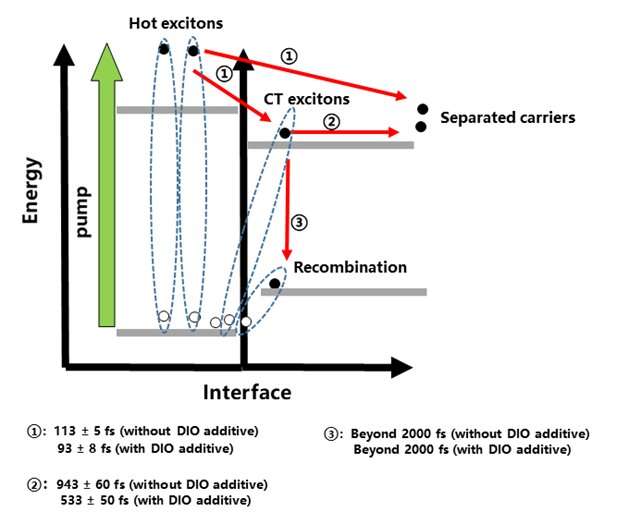A schematic of ultrafast interfacial excitons dynamics in the P51:PC71BM blend after photoexcitation. Credit: SIOM
Recently, researchers from the Shanghai Institute of Optics and Fine Mechanics of the Chinese Academy of Sciences (CAS) have made progress in ultrafast dynamics of polymer solar cells (PSCs) with Soochow University.
The research team used femtosecond transient absorption technology to study active layer of organic solar cells, explaining the contribution of 1,8-diiodooctane (DIO) additives to the efficiency enhancement of PSCs. The results have been published in Nanomaterials.
As a new type of solar cell device, PSCs have the advantages of light weight, mechanical flexibility and low-cost fabrication. But low efficiency is the main limit of its large-scale application.
The research team studied the effect of DIO additives on photocarrier generation in donor materials (P51) and bulk heterojunction films (P51:PC71BM) by pump-probe measurement.
They found that the introduction of DIO additives could improve the lifetime of polaron pairs in P51, which was beneficial to the photocarrier generation. Moreover, in bulk heterojunction films (P51:PC71BM), DIO additives could promote free charge generation as well as charge transfer excitons generation and separation.
From the aspect of ultrafast dynamics, these results reveal the effect of DIO on carrier generation and separation, providing an effective route to improve the efficiency of nanoscale polymer solar cells.
More information: Tongchao Shi et al. Ultrafast Charge Generation Enhancement in Nanoscale Polymer Solar Cells with DIO Additive, Nanomaterials (2020). DOI: 10.3390/nano10112174
Provided by Chinese Academy of Sciences
























